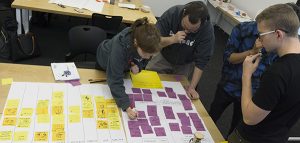biomimicry
Exercise
Biomimicry Principles
 Time Estimate: 30—120 minutes
Time Estimate: 30—120 minutes
 Goal: Generate new ideas to improve your product (or service) using a list of biomimicry principles.
Goal: Generate new ideas to improve your product (or service) using a list of biomimicry principles.
Biomimicry can be done directly or indirectly. Here you’ll do the indirect method, brainstorming from general principles of nature that are listed by experts. While principles may not be as inspiring or personal as finding a specific design hero in nature, sometimes you don’t have time or resources for that, and you need something faster and easier to apply.
STEP 1: Understand & Select Natural Principle(s)
 Time Estimate: 10—40 minutes
Time Estimate: 10—40 minutes
Many scientists, designers, and engineers have already identified common ways in which nature designs differently from industry. Three good lists are the Biomimicry 3.8’s “Life’s Principles” list (see The Biomimicry DesignLens for more information), Steven Vogel’s list of mechanical engineering principles from the book “Cats’ Paws and Catapults”, and Jeremy Faludi’s list of other biological principles.


Left: Life’s principles, from Biomimicry 3.8. Right: Cats’ Paws and Catapults, by Steven Vogel.
Read through one or more of these lists, and pick a principle (or a few) that you think would be most fruitful for brainstorming new ideas to make your product or system more sustainable.
STEP 2: Brainstorm From Natural Principle(s)
 Time Estimate: 10—40 minutes
Time Estimate: 10—40 minutes
Now that you have a useful natural principle (or a few), you can use them as design inspiration. Brainstorm how you could improve your product’s design based on the principle you chose. Have as many ideas as you want, at least 20 (50 is better), and write or sketch them in whatever format you want. If you chose more than one natural principle, have a separate brainstorm for each one.

STEP 3: Choose Solution & illustrate
 Time Estimate: 10—40 minutes
Time Estimate: 10—40 minutes
After the brainstorm, choose a winning idea (or a couple) that you might want to further pursue. Illustrate it in a sketch, rendering, physical model, or other means to communicate both how it works and why it’s a valuable idea.

Illustration from MCAD assignment by Mark Chamberlain and Megan Graham, 2017.
Checklist for Self-Assessment
To score your success on this exercise, see if you…
- Clearly identified what principle(s) you brainstormed on
- Brainstormed at least 20 ideas
- Clearly described the resulting design
- Illustrated the resulting design
All VentureWell Tools for Design and Sustainability content is shareable and usable by CC BY-NC-SA 4.0 license.